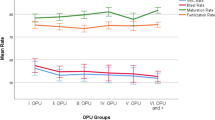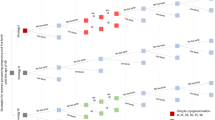Abstract
A discrete time survival problem arising in studies of artificial insemination by donor is described. This problem involves two levels of “ frailty” effect to model heterogeneity of female fecundability, together with a further two nested sets of random effects for sperm donor and donation. Parametric and non-parametric approaches to modelling such data are discussed, and computational difficulties highlighted. Attention is also drawn to the relationship of such problems to the extensive literature on generalised linear mixed models.
Access this chapter
Tax calculation will be finalised at checkout
Purchases are for personal use only
Preview
Unable to display preview. Download preview PDF.
Similar content being viewed by others
References
M. Aitkin and B.J. Francis. GLIM4 macros for nonparametric maximum likelihood estimation with overdispersion and variance component models in the exponential family. The GLIM Newsletter (submitted), 1995.
N.E. Breslow and D. Clayton. Approximate inference in generalized linear mixed models. Journal of the American Statistical Association, 88:9–25, 1993.
A.S. Bryke and S.W. Raudenbush. Hierarchical Linear Models: Applications and Data Analysis Methods. Sage publications, Newbury Park, 1992.
D. Clayton. A model for association in bivariate life tables and its application in epidemiological studies of familial tendency in chronic disease incidence. Biometrika, 65:141–151, 1978.
D. Clayton. Generalized linear mixed models. In W.R. Gilks, S. Richardson, and D. Spiegelhalter, editors, Markov Chain Monte Carlo in Practice. Chapman and Hall, London, 1994.
M.R. Conoway. A random effects model for binary data. Biometrics, 46:317–328, 1990.
D.R. Cox. Regression models and life tables (with discussion). Journal of the Royal Statistical Society, Series B, 34:187–220, 1972.
R.J. Carroll and D. Ruppert. Robust estimation in heteroscedastic linear models. Annals of Statistics, 10:429–441, 1982.
H. Goldstein. Multilevel mixed linear model analysis using iterative generalized least squares. Biometrika, 73:43–56, 1986.
P. Hougaard. Life table methods for heterogeneous populations: distributions describing the heterogeneity. Biometrika, 71:75–83, 1984.
P.J. Huber. The behaviour of maximum likelihood estimates under non-standard conditions. In Proceedings of the Fifth Berkely Symposium on Mathematical Statistics and Probability, I, pages 221–223. 1967.
J.J. Heckmann and J.R. Walker. Estimating fecundability from data on waiting times to first conception. Journal of the American Statistical Association, 85:283–295, 1990.
J.P. Hinde and A.T.A. Wood. Binomial variance component models with a non-parametric assumption concerning random effects. In R. Crouchley, editor, Longitudinal data analysis. Avebury, Aldershot, Hants, 1990.
J.O. Irwin. A note on the subdivision of X 2 into componenents. Biometrika,36:130, 1949.
H.O. Lancaster. The derivation and partition of X 2 in certain discrete distributions. Biometrika,36:117, 1949.
Y. Lee and J.A. Neider. Hierarchical generalized linear models. Journal of the Royal Statistical Society, Series B, 58:1, 1964.
J.A. Little and D.B. Rubin. Statistical Analysis with Missing Data. Wiley Series in Probability and Mathematical Statistics. Wiley, New York, 1987.
K.Y. Liang and S.L. Zeger. Longitudinal data analysis using generalized linear models. Biometrika, 73:13–22, 1986.
C.A. McGilchrist and C.W. Aisbett. Regression with frailty in survival analysis. Biometrics, 47:461–466, 1991.
C.A. McGilchrist. REML estimation for survival models with frailty. Biometrics, 49:221–225, 1993.
D. Oakes. A model for association in bivariate survival data. Journal of the Royal Statistical Society, Series B, 44:414–422, 1982.
D. Oakes. Semi-parametric inference in a model for association in bivariate survival time data. Biometrika, 73:353–361, 1986.
M.C. Sheps. On the time required for conception. Population Studies, 17:85–97, 1964.
M.C. Sheps and J. A. Menken. Mathematical models of conception and birth. University of Chicago Press, Chicago, 1973.
C.R. Weinberg, D.D. Baird, and A.J. Wilcox. Sources of bias in studies of time to pregnancy. Statistics in Medicine, 13:671–681, 1994.
C.R. Weinberg and B.C. Gladen. The beta-geometric distribution applied to comparatitive fecundability studies. Biometrics, 42:547–560, 1986.
H. White. A heteroskedasticity-consistent covariance matrix estimate and a direct test for heteroskedasticity. Econometrika, 48:817–830, 1980.
A.I. Yashin and I.A. Iachine. Genetic analysis of durations: correlated frailty model applied to survival of Danish twins. Genetic Epidemiology, 12:529–538, 1995.
S.L. Zeger and M.R. Karim. Generalized linear models with random effects; a gibbs sampling approach. Journal of the American Statistical Association, 86:79–86, 1991.
Editor information
Editors and Affiliations
Rights and permissions
Copyright information
© 1997 Springer-Verlag New York, Inc.
About this paper
Cite this paper
Clayton, D., Ecochard, R. (1997). Artificial Insemination by Donor: Discrete time survival data with crossed and nested random effects. In: Lin, D.Y., Fleming, T.R. (eds) Proceedings of the First Seattle Symposium in Biostatistics. Lecture Notes in Statistics, vol 123. Springer, New York, NY. https://doi.org/10.1007/978-1-4684-6316-3_7
Download citation
DOI: https://doi.org/10.1007/978-1-4684-6316-3_7
Publisher Name: Springer, New York, NY
Print ISBN: 978-0-387-94992-5
Online ISBN: 978-1-4684-6316-3
eBook Packages: Springer Book Archive




